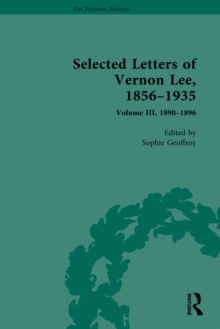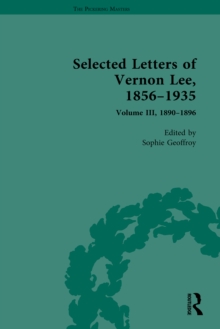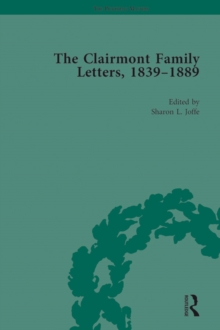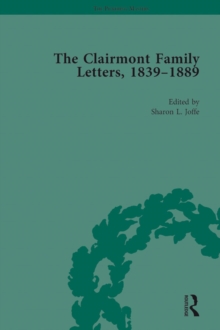
Selected Letters of Vernon Lee, 1856–1935 : 1890-1896 Hardback
by Sophie Geoffroy, Amanda Gagel
Part of the The Pickering Masters series
Hardback
- Information
Description
Vernon Lee was the chosen name of Violet Paget (1856–1935), a prolific author best known for her supernatural fiction and her radical polemics.
She was also an active letter writer whose correspondents include many well-known figures in fin de siècle intellectual circles across Europe.
This multi-volume scholarly edition presents a comprehensive selection of her English, French, Italian, and German correspondence — compiled from more than 30 archives worldwide — that reflect her wide variety of interests and occupations as a Woman of Letters, philosopher, psychologist and political activist.
Letters written in a language other than English have been expertly translated by scholars Sophie Geoffroy (from the French), Crystal Hall (from the Italian), and Christa Zorn (from the German).
Full transcriptions of some 2000 letters are arranged in chronological order along with introductions, biographical notes and detailed footnotes that explain their context and identify the recipients, friends and colleagues mentioned. In this third volume, covering the years 1890-1896, the 429 assembled letters follow Violet Paget-Vernon Lee from the age of thirty-four, when she lives with her parents and half-brother, the poet and invalid Eugene Lee-Hamilton, at Villa Il Palmerino (Florence), to the ripe age of forty, when both her parents died and her brother recovered from his illness and decided to leave home. As Lee copes with Eugene’s invalidism and her own physical and psychological ailments, we get a view of the practice and teaching of medicine and nursing in Europe in the late 1890s.
Lee sponsors her friend’s Amy Turton’s convalescent home and nurses’ training.
Mental sciences are at the forefront, from experimental psychology, psychiatry and neurology to neurophysiology; and in August 1892, Vernon Lee and Clementina Anstruther-Thomson attend the Psychological Congress in Paris, with speakers Hermann von Helmholtz, James Sully, Alexander Bain, Francis Galton, G.
Stanley Hall, and Amboise-Auguste Liebeault. Lee came to consider herself as a psychologist as much as a philosopher of art and delved more deeply into experimental psychology; and with her partner Clementina Anstruther-Thomson she refined a theory of aesthetic empathy and inner mimicry.
According to this theory, a viewer’s response to a work of art can be measured through his or her physiognomy, breathing, heartbeats and eye and muscular movements, thus providing a scientific basis for an innate appreciation of aesthetic value.
They published a synthesis of their work: “Beauty and Ugliness” (The Contemporary Review, October-November 1897). While travelling, Lee continues to write her travel essays (e.g.
Genius Loci: Notes on Places, 1899) and her popular supernatural tales.
She starts lecturing, emulating Eugénie Sellers’s British Museum lectures and her method for attribution and connoisseurship. Her interest in socialism and political economy intensify as her circle widens beyond an aristocratic and society milieux to working-class districts, and her collection Althea (1894) shows her interest in ethics, moral duties and free-thinking.
She indicts the proponents of art for art’s sake. Her discussions about contracts, copyright and royalties, pirated editions, and money matters are intertwined with educational ethics and a concern for the fair recognition of women’s higher education and careers.
She becomes involved in the university extension program by giving her first lectures on ancient art and aesthetics in the East End and at Toynbee Hall, and her experience of lecturing in London, Cambridge, Oxford and Rome allows her to meet other intellectuals: Eugénie Sellers, Mrs Arthur Strong etc. and new audiences. In 1894 the Affaire Dreyfus (1894–1906) begins, revealing the rise of anti-Semitism targeting many of Lee’s close friends, also defenders of Dreyfus, such as James Darmesteter.
After he died, Darmesteter’s wife, Mary (Robinson) and Lee once again became close to one another. By the time she turned forty, Vernon Lee experienced several emotional blows: her friend and mentor Walter Pater died on 30 July 1894.
That same year, four months later, on 14 November 1894, her father died from complications related to asthma, Eugene Lee-Hamilton started to recover from chronic illness soon after his stepfather’s death.
Eighteen months after her father’s death, Lee was hit again in the death of her mother on 8 March 1896.
Feeling vulnerable, Lee made her will (1896), asking Eugene and Bella Duffy to act as executors— “clinging to” the Palmerino: “the only thing I care for in the world”. In the present volume, she meets for the first time the Italian actress Eleonora Duse, also Lady Margaret Brooke, Ranee of Sarawak; G.B.
Shaw; and the composer Ethel Smyth. In France she meets archaeologist, explorer and novelist Jane Henriette Dieulafoy; American painter Mary Cassatt; geographers Edouard Blanc (Marie-Thérèse Blanc’s son) and Jean Brunhes; philanthropist and feminist activist Gabrielle Alphen-Salvador; connoisseur and art collector Gustave Louis Dreyfus and his wife Henriette (suggests Olive Anstruther-Thomson as a tutor or “female lad” for their son, Carle Dreyfus who was to become curator at the Louvre).
She also met art expert Albert Sancholle Henraux and his wife Maria del Carmen (Carlo Placci’s sister); illustrator Albert Lynch; painter and printmaker Paul-Albert Besnard; and the Empress Eugénie (Eugénie de Montijo), but also Paul Desjardins and his circle at the Union morale including Daniel Halévy,. Lee’s Correspondents in this volume include her parents, Matilda and Henry Ferguson Paget; her half-brother poet Eugene Lee-Hamilton; Italian Countess Angelica (Pasolini) Rasponi, Percy William Bunting, French translator and critic Marie-Thérèse Blanc (“Th.
Bentzon”), Clementina Anstruther-Thomson, Guido Biagi, Paul Desjardins, Enrico Nencioni, Conte Giovanni Gigliucci, Bernard Berenson, Mary Ward (Mrs Humphry Ward), William Blackwood, Marie Belloc Lowndes, Mary Darmesteter, Lady Susan Elizabeth (Mary) Constantine Jeune (later St Helier), Harry Brewster, Carlo Placci, Lady Charlotte Julia Blennerhassett, Gaetano Salvemini, Lady Louisa Wolseley, Richard Garnett, Ethel Gwendoline Moff at Vincent, Alice Foulon de Vaulx, Alys Pearsall Smith (Mrs Russell) and Hannah Whitall Smith (Mrs Pearsall Smith).
Information
-
Out of StockMore expected soonContact us for further information
- Format:Hardback
- Pages:410 pages, 6 Halftones, black and white
- Publisher:Taylor & Francis Ltd
- Publication Date:22/12/2023
- Category:
- ISBN:9781848934979
£115.00
£107.39
Information
-
Out of StockMore expected soonContact us for further information
- Format:Hardback
- Pages:410 pages, 6 Halftones, black and white
- Publisher:Taylor & Francis Ltd
- Publication Date:22/12/2023
- Category:
- ISBN:9781848934979



